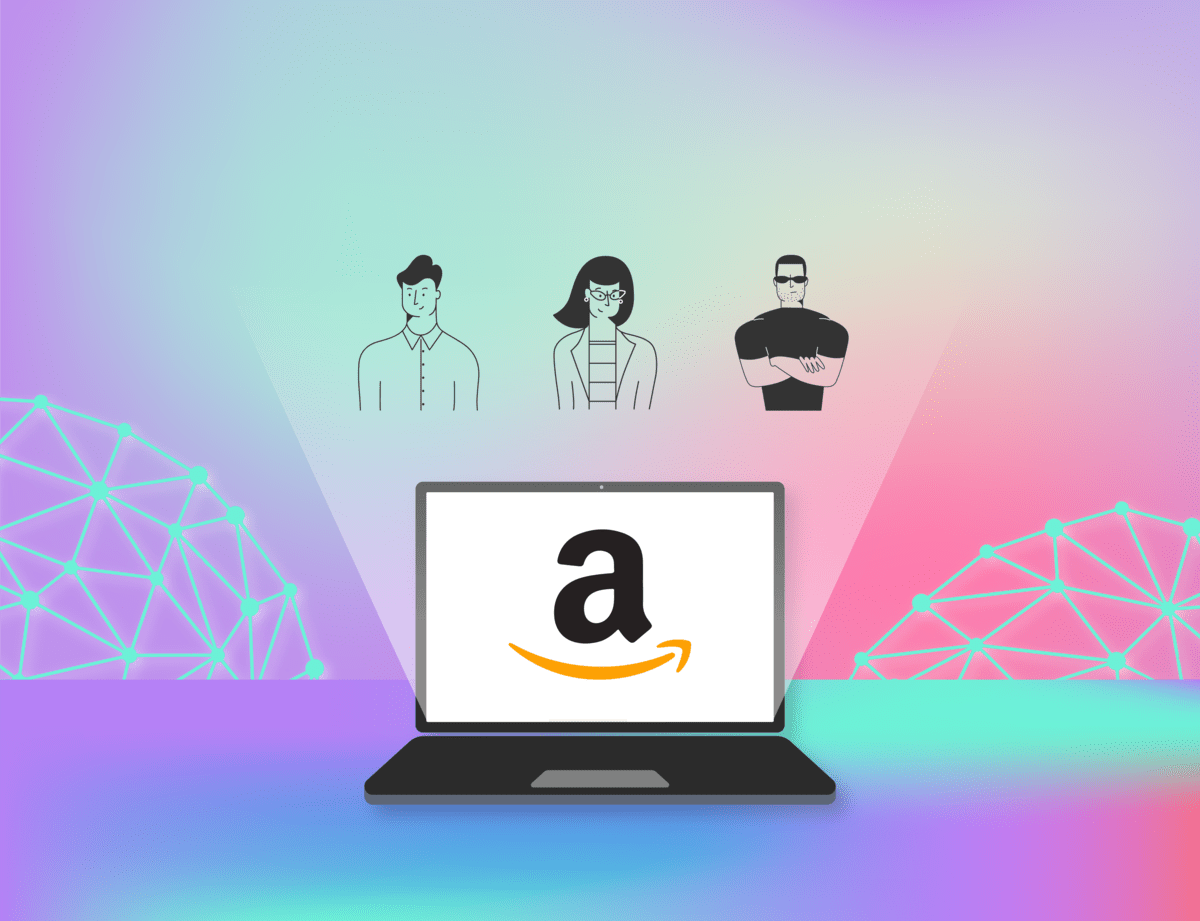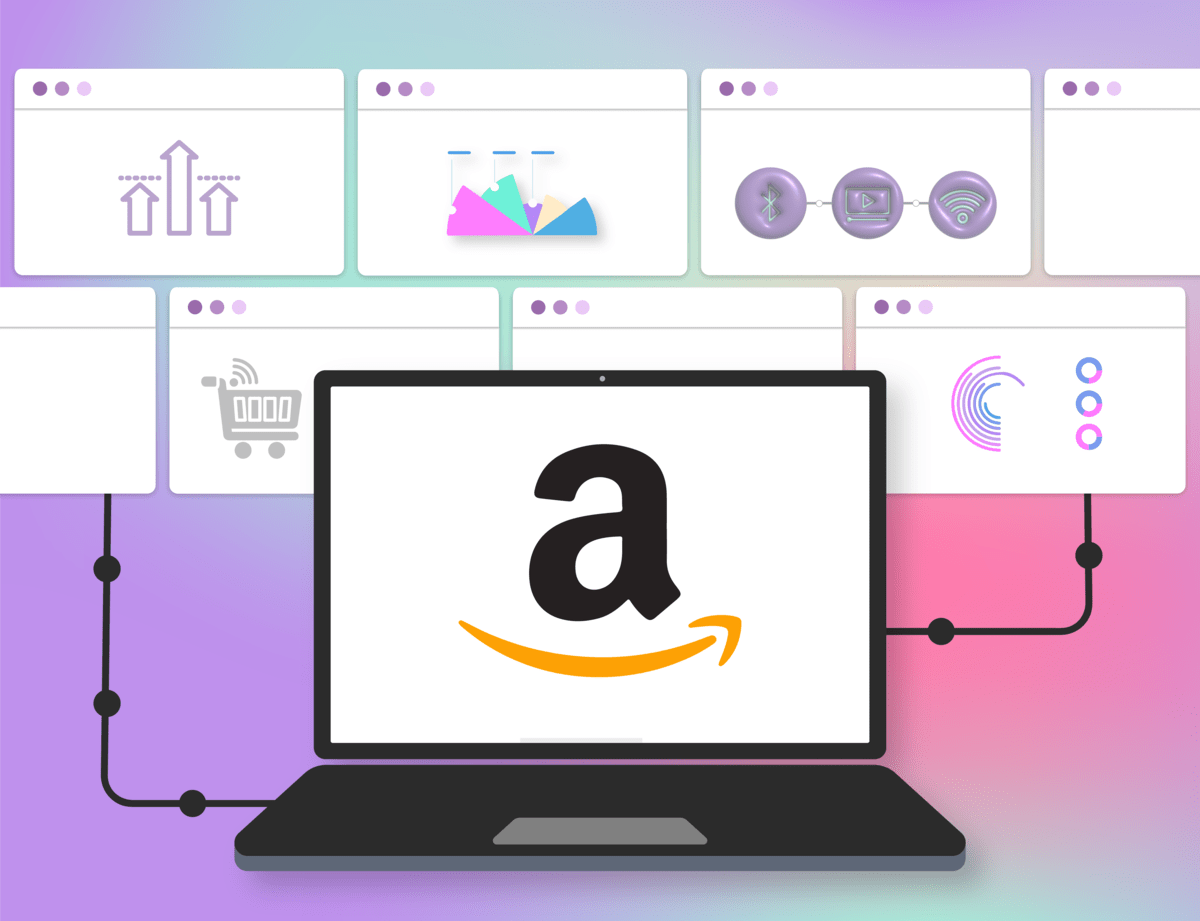A DSP (demand-side platform) is an advertising platform that uses automation to sell ad placements through real-time bidding.
DSPs allow advertisers and agencies to buy ad inventory programmatically and at scale, increasing campaign effectiveness and boosting return on ad spend (ROAS).
The Amazon DSP is one of the newest on the market, launching in 2018. However, by 2020, it had already surpassed a market share of 10% and continues to grow — Insider Intelligence estimates that Amazon’s ad revenue in the US will hit $30 billion in 2023.
One of the key factors in Amazon DSP’s popularity is its access to high-quality customer data and the ability to reach audiences both on and off Amazon.
This article will cover some of the unique benefits of Amazon DSP and the types of campaigns advertisers can use it to create.
5 Reasons to Use Amazon DSP Campaigns
eMarketer reports that, in 2021, over 60% of advertisers using DSPs in the US used Amazon DSP’s self-service option. So what’s behind the meteoric rise of Amazon DSP advertising? Let’s take a look at five of its unique benefits.
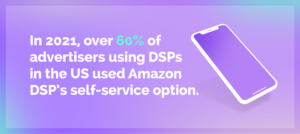
1. Reach a Relevant and Engaged Audience at Scale
Amazon DSP gives you access to ad inventory on the Amazon website and other Amazon-owned and operated sites and apps — such as Fire TV, Audible, Woot, Goodreads, Freevee (formerly IMDb), ShopBop, Twitch, Zappos, and Prime Video.
But that’s not all. The Amazon demand-side platform enables advertisers to reach Amazon audiences wherever they are through Amazon Publisher Services and third-party exchanges. This means it can serve ads to your target customers anywhere they spend time online.
The best part is that the data is extremely reliable and not available on other platforms. This is Amazon’s first-party data that targets people who have been searching or shopping for specific products and then identifies the best placements to serve ads to those people.
Since Amazon boasts unrivaled quantities of shopping data, Amazon DSP can help advertisers scale their advertising campaigns to reach more people with more relevant messages.
2. Access Advanced Audience Targeting
Most DSPs use target audience modeling to predict user interests and preferences based on common attributes such as demographics, geolocation, online behavior, and the devices they use. Amazon DSP’s targeting options go way beyond prediction by drawing data on real users and their behavior.
Amazon DSP’s data is based on real search, browsing, and purchase history — all of which can be leveraged for targeting. For example, if you own a pet store, you could target users who have a history of searching for, browsing, and purchasing pet products such as dog food, toys, and harnesses or leashes.
What’s unique about this data is that it’s only available through Amazon DSP — so it’s no wonder so many advertisers are flocking to this platform.
First of all, Amazon’s data is second to none. They have access to information about everyone who:
- Shops on Amazon
- Listens to Prime Music
- Shops at Whole Foods
- Reads books on Kindle
- Streams video content on Freevee and Amazon Prime Video
- Registers a product on Amazon
- Registers their vehicle on Amazon Garage
This means you can use Amazon data for extremely precise targeting — you can even target users based on the products they buy using the Amazon Standard ID Number (ASIN) for each product.
You can also target Amazon audiences based on the type of content they watch on Prime Video, including:
- Genre
- Actor
- Director
- TV show
- Movie title
- Live and on-demand events
- Sports channels such as NFL, MLB, the Premier League, and ATP
3. Develop Brand Awareness
If you want to be at the forefront of your customer’s mind when they decide it’s finally time to make a purchase, you’ll need to make contact at different points throughout their customer journey with your marketing messages.
Amazon DSP can help you develop brand awareness by reminding customers about your products or services. Developing brand awareness is crucial for any business that aims to grow, as it helps your customers become familiar with your brand and increases brand trust.
Since Amazon DSP isn’t limited to Amazon advertising, it can also introduce your brand to new users on the third-party platforms they use to research competitors’ products.
4. Optimize Your Ad Campaigns
Amazon DSP allows you to easily optimize your campaigns — either manually or algorithmically — to meet specific goals.
Manual optimization lets you update many aspects of a campaign, including budgets, audiences, bids, and frequency caps.
Programmatic optimization:
- Dynamically updates budgets based on campaign goals.
- Adjusts ads so that they’re served through the best sites using the best formats.
- Automatically analyzes every impression against campaign goals. Amazon applies up to 500,000 predictors based on its customers’ shopping patterns.
5. Access Audience Insights and Campaign Performance Analytics
Amazon DSP advertisers get access to the audience insights data and campaign performance metrics that provide essential information about purchasing behavior.
For example, reports provide an overview of customer actions before, during, and after the campaign, allowing advertisers to see the point at which customers stop before completing a purchase.
This data can help advertisers optimize their campaigns in real-time and use it for retargeting customers who fail to follow all the way through on their purchases.
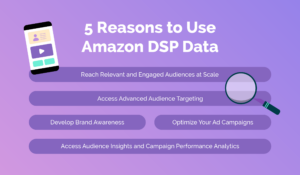
Types of Amazon DSP Campaigns You Can Create
Amazon DSP offers a variety of advertising options that can be used at different stages of the customer journey. This can help you deliver quality ad experiences and reach audiences at your preferred touchpoints.
You can create three types of ads on Amazon DSP: display, video, and audio. Let’s take a look at how each of them works.
Display advertising
Display ads are among the most popular and versatile ad types and can appear in a variety of sizes and formats.
Display ads can be served on desktop, mobile devices, and mobile apps across Android, Fire Tablets, and iOS devices. They may appear in-app, on a website, or as a mobile interstitial — an ad that takes over the screen for a brief period of time.
Display ads include:
- Dynamic ads — automatically select which creative is served based on campaign goals and user behavior.
- Static ads — unlike dynamic ads, static don’t change based on behavior in real-time; instead, they serve the same ad to multiple users. Static ads are good for generic seasonal offers such as Black Friday discounts or providing CTAs that redirect to a landing page.
Both dynamic and static ads can take a variety of formats, including:
- Banner ads
- Native ads
- Interactive content
- Animations
- Lightbox ads
- Short videos
Video ads
There are two main types of video ads: online and over-the-top (OTT) ads. Online video ads are part of the browsing experience and are usually placed before, during, or after the video content a user is viewing — for example, a YouTube video.
OTT ads are programmatic adverts delivered via an over-the-top streaming platform, such as Amazon Prime Video, or ConnectedTV (CTV) (which Amazon calls Streaming TV, or STV) devices, such as a games console or Amazon FireStick, and can also be placed pre, mid, or post-roll.
Audio ads
Audio ads allow you to connect with your audience during those moments when they’re away from their screens, such as when they listen to music, podcasts, or audiobooks.
Like display ads, they can be either dynamic or static and can be placed before, during, or after the content.
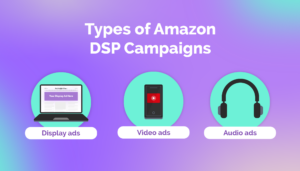
Reach More People with Amazon DSP
Put simply, working with Amazon DSP allows you to leverage the massive amounts of high-quality customer data that only the e-commerce giant has access to.
Using Amazon DSP can help you refine your target audience, optimize your campaigns, and extend your reach so that your marketing messages impact the right people at the right time.
Many advertisers and agencies choose to partner with programmatic advertising specialists — such as Grapeseed Media — to implement their Amazon DSP advertising strategy. We create data-driven, expertly crafted programmatic solutions that drive traffic and conversions and optimize ROAS. Get in touch with us today to discover how we can help you.





